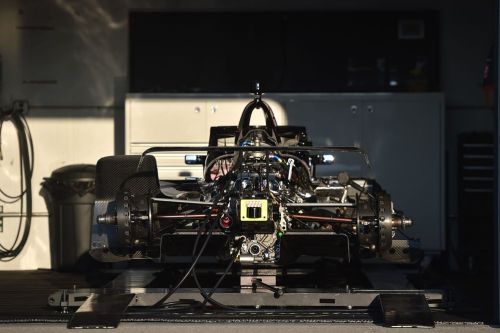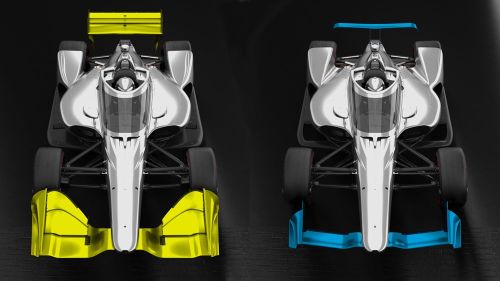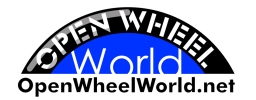Which parts of an IndyCar can teams develop themselves?
 The IndyCar Series is known as a spec series, meaning that everyone competes with (almost) the same equipment. To the naked eye, there's only one difference between the cars: half of the field uses Honda engines, while the other half has Chevrolet engines. Even these engines are heavily restricted in terms of development, with regulations ensuring that no manufacturer gains too much of an advantage over the other.
The IndyCar Series is known as a spec series, meaning that everyone competes with (almost) the same equipment. To the naked eye, there's only one difference between the cars: half of the field uses Honda engines, while the other half has Chevrolet engines. Even these engines are heavily restricted in terms of development, with regulations ensuring that no manufacturer gains too much of an advantage over the other.Yet, some teams are often stronger than others. Of course, top teams like Team Penske, Chip Ganassi Racing, Andretti Autosport, and McLaren have the financial resources to poach talented personnel from weaker teams, including drivers. However, there are a few areas where teams have the freedom to make their cars faster through technical developments.
The Hidden Gold in IndyCar: Dampers
You can't see them, but teams spend a lot of time and money optimizing them: the dampers. This is the most critical component where teams can make a difference. Teams have their own damper programs or collaborate with competitors on damper development.
 Both the tires and most of the suspension components are the same for all teams, but the dampers determine how the tire interacts with the track surface. A damper that's too stiff will cause the car to bounce too much over bumps or curbs, while one that's too soft will hurt the car's drivability.
Both the tires and most of the suspension components are the same for all teams, but the dampers determine how the tire interacts with the track surface. A damper that's too stiff will cause the car to bounce too much over bumps or curbs, while one that's too soft will hurt the car's drivability.Teams have the option to develop their own dampers. They first test these on a ‘shaker rig’—a device that simulates the bumps, banking, and loads on the car for a specific type of circuit. This allows a team to test whether the developed dampers meet the required standards for a track before the race. Various dampers and corresponding settings can also be tested.
Because dampers are the most crucial component where teams can make a difference, you’ll always see them covered in the IndyCar paddock or pit lane when not being worked on. This is where the real secrets of the teams lie!
Other Parts with Development Freedom
Besides dampers, the regulations include a list of parts that teams are free to develop. Most of these parts have little or no impact on the car’s performance; at most, teams can save some weight to make the car slightly faster.
The full list of parts where teams have the freedom to develop includes:
- All non-engine-related oils and lubricants
- Dampers
- Coatings inside the gearbox and gearbox interior
- Coatings of all bearings
- Bearings and bearing rings (excluding uprights and gearbox bearings), provided they are exactly the same size, type, and design as approved by the official manufacturer
- Hybrid and/or ceramic bearings are not allowed
- The fuel cell collector
- The end of the fuel tank hose that connects to the tank
- Internal brake lines
- The cable used to adjust brake balance (as long as the concept remains identical to the cable supplied by Dallara)
- Bushings and rubber components
- Water / oil lines:
- Water lines
- Oil lines (as long as a 15 cm flexible line remains on the radiator side of the line)
- Lines from the fuel cell
- Rings
- Drive pin extensions
- Pushrod ends (suspension)
- Anti-rotation devices are allowed on pushrods and tie rods, as long as they remain parallel to the mounting surface
- Anti-roll bar adjusters (must be approved by IndyCar via IRIS)
- Nuts and bolts, including bolt heads
- Heat shielding
- Pedal heads (must be approved by IndyCar via IRIS)
- Speedway front wing adjuster knob
- Brake master cylinder extensions
- Throttle pedal damping extensions
- Brake pedal bushing
- Shaft seals
- Studs, with exceptions in 13 positions (ranging from spots on the front wing, suspension, gearbox, and engine mounting)
Reproducing Parts
In addition to developing the parts listed above, teams are also allowed to reproduce certain parts. However, these must be identical to the approved drawings of these parts. The list of reproducible parts ranges from the air jack and pedals to anti-roll bars. Teams can choose whether to produce these themselves or purchase them directly from Dallara.
Various Aerodynamic Options Available
 On the aerodynamic front, all teams have access to the same parts. However, this doesn't mean that every car is aerodynamically identical. The regulations provide lists of options for components such as the front wing, rear wing, underwing (the car's underside), and brake ducts.
On the aerodynamic front, all teams have access to the same parts. However, this doesn't mean that every car is aerodynamically identical. The regulations provide lists of options for components such as the front wing, rear wing, underwing (the car's underside), and brake ducts.Depending on the type of circuit (Indy 500, Texas Motor Speedway, short oval, or permanent/street circuits), each part is specified as mandatory, optional, or prohibited.
Teams are allowed to experiment with the aerodynamic configuration of the available options during practice. However, once qualifying is over, the car must remain in that configuration until the race. This rule applies to the chosen options, not their settings.
If a team needs to make changes to the selected aerodynamic options after qualifying, a penalty will follow. If the change is approved by IndyCar, the driver will be moved to the last starting position on the grid. Without IndyCar’s approval, the driver will also receive at least a drive-through penalty, which must be served during the race.
